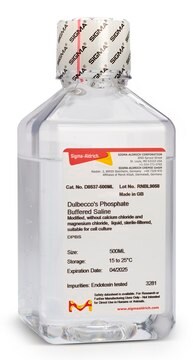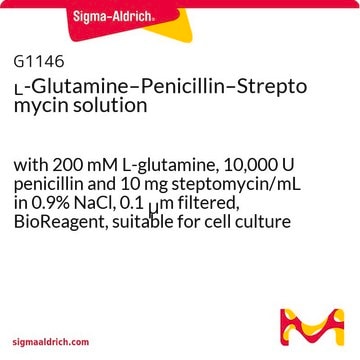As per the Product Information Sheet, the Accutase solution does not contain mammalian or bacterial-derived products. This solution is supplied as a sterile, ready-to use, frozen liquid. This product is serum free.
A6964
Accutase® solution
sterile-filtered, suitable for cell culture
Synonym(s):
Cell detachment solution
About This Item
Recommended Products
sterility
sterile-filtered
Quality Level
form
liquid
concentration
400-600 units/mL
technique(s)
cell culture | mammalian: suitable
single cell analysis: suitable
impurities
≤1 EU/mL endotoxin
pH
6.8-7.8
shipped in
dry ice
storage temp.
−20°C
General description
Application
Suitable for use in preparation of single cell suspension for sequencing.
Features and Benefits
Formula variant
Preparation Note
Legal Information
related product
Storage Class Code
12 - Non Combustible Liquids
WGK
WGK 1
Flash Point(F)
Not applicable
Flash Point(C)
Not applicable
Choose from one of the most recent versions:
Certificates of Analysis (COA)
Don't see the Right Version?
If you require a particular version, you can look up a specific certificate by the Lot or Batch number.
Already Own This Product?
Find documentation for the products that you have recently purchased in the Document Library.
Customers Also Viewed
Articles
Use of MULTI-seq lipid-modified oligos, protocol, and troubleshooting guide for PCR Assays and Sequencing applications.
Frequently asked questions about neural stem cells including NSC derivation, expansion and differentiation.
PLTMax® Human Platelet Lysate (hPL) is a superior serum-free and xeno-free media supplement alternative to fetal bovine serum (FBS) for human mesenchymal stem cell (MSC) cultures.
Derivation and characterization of functional human neural stem cell derived oligodendrocyte progenitor cells (OPCs) that efficiently myelinate primary neurons in culture.
Protocols
Mesenchymal Stem Cells and Media enable in vitro expansion and differentiation, vital for various tissue sources.
A stem cell culture protocol to generate 3D NSC models of Alzheimer’s disease using ReNcell human neural stem cell lines.
Step-by-step stem cell culture protocols for human induced pluripotent stem cells (iPSCs) including ips cell thawing, expanding, freezing and characterizing.
Step-by-step culture protocols for neural stem cell culture including NSC isolation, expansion, differentiation and characterization.
Related Content
Defined culture conditions. Consistent growth of human cancer cell lines in PromoCell’s serum-free/xeno-free Cancer Cell Line Media-XF. Explore over 350 PromoCell products on Sigma.com
-
Is Accutase Solution A6964 animal-origin free? Is serum free?
1 answer-
Helpful?
-
-
Can accutase be thawed, aliquoted, and refrozen at -20 to preserve it longer?
1 answer-
Yes, this product is stable after undergoing several freeze/thaw cycles. The thawed product may be aliquoted and stored at –20 °C or stored for up to 2 months at 4°C.
The graphic below demonstrates the freeze/thaw stability of Accutase.Helpful?
-
-
On the Innovative cell technologies website it says that accumax is the same as accutase but with 3x the amount of enzymes. Why did the technician here answer that it contains DNAse?
1 answer-
Thank you for calling this to our attention. The manufacturer, Innovative Cell Technologies, has been contacted regarding this matter. The manufacturer has confirmed that both Accutase and Accumax products DO contain a small amounts of DNAse. The concentration is not measured, but it is present in the formulation. In addition, both products also contain 0.5 mM EDTA.
Helpful?
-
-
For what purposes can Product A6964, Accutase® solution, be used?
1 answer-
It can be used for detaching cells, analysis of cell surface markers and virus growth assays.
Helpful?
-
-
Will Product A6964, Accutase® solution, work on tissue?
1 answer-
This product is not tested for tissue, but it should work on soft tissue.
Helpful?
-
-
Does Product A6964, Accutase® solution, contain animal components?
1 answer-
Accutase is purified from a marine invertebrate. There are no other animal or bacterial derived proteins present.
Helpful?
-
-
What is the Department of Transportation shipping information for this product?
1 answer-
Transportation information can be found in Section 14 of the product's (M)SDS.To access the shipping information for this material, use the link on the product detail page for the product.
Helpful?
-
-
What is the appropriate cell dissociating product to be used for ES cells that will be injected into blastocysts?
1 answer-
Accutase®, product A6964, or Accumax™ (Accutase® with DNase), product A7089, will work well for dissociation of ES cells. The Accutase® product has protease and dispase activity to dissociate the cells. The Accumax™ product also has DNase to limit the aggregation that is caused by DNA released from ruptured cells during the dissociation/scraping.Please see the reference and link below for more information on the use of Accutase® with ES cells:Mol Reprod Dev. 2008 May;75(5):818-27
Helpful?
-
-
What is the concentration of Product A6964, Accutase® solution?
1 answer-
This product is typically at a concentration of 400-600 units/mL.
Helpful?
-
-
What is the difference between Accutase and Accumax?
1 answer-
Accutase is a mixture of non-mammalian proteases. Accumax is accutase that has been augmented with DNase to reduce clumping associated with DNA release from damaged cells.
Helpful?
-
Active Filters
Our team of scientists has experience in all areas of research including Life Science, Material Science, Chemical Synthesis, Chromatography, Analytical and many others.
Contact Technical Service
















